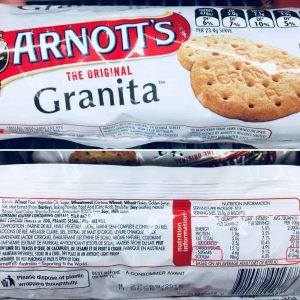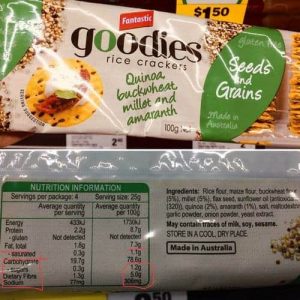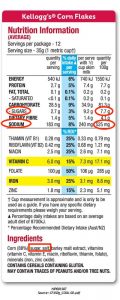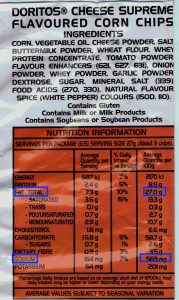
29 Apr Misleading food labels?
I popped into the shops quickly the other day for some groceries and came across some “gourmet” cracker or savoury biscuits that give the impression that they are more “wholesome” than other crackers you would use with dips on a Sunday afternoon cheese and wine snack.
On reading the food label and ingredients list of the savoury crackers, I was struck by the quantity of sugar added to what would normally be seen as salty or savoury biscuits and why it is needed. Savoury biscuits are already typically renowned for high salt content, so to add sugar to the mix, further fuels the likelihood of developing a chronic disease such as coronary heart disease, diabetes, high blood pressure etc and reiterates why Australia has one of the highest rates of obesity and overweight people in the world.

Before I talk about this product and compare it with some others, here is a handy downloadable wallet size guide to check reference values of fat, sugar, salt and fibre against food products. In future blogs I will go into more details about how to read food labels, so this blog is more about how food companies can mislead consumers and how important it is to read food labels as the untrained eye can be caught off guard as to the ingredients in a food product.
Using the Live Lighter picture, as a guiding reference to compare “per 100g”, let’s look at these crackers that caught my attention:
BFINEST SPECIALTY CRACKERS – SUNFLOWER & THYME

Who would have thought savoury crackers with a label that doesn’t suggest that even dried fruit has been added, would have added sugar. Not only that, but sugar is SECOND on the ingredient list and honey is FOURTH! If you compare the food label reference guide and the food label on this product, you can easily see that fats, salt (sodium) AND sugar (!) are above the recommended values. As a comparison, I am also illustrating a sweet biscuit below, the famous Arnott’s Granita biscuit – not the sweetest biscuit on the market but LOWER in sugar than Bfinest Specialty Crackers!


The fat content in the BFinest Specialty Crackers is higher than recommended, however, this is likely to be coming from the yoghurt and the sunflower/sesame seeds (so some good fats in there too and it helps to boost the fibre levels). Looking at this brand of biscuits, as they are toasted and brown with seeds mixed in, it does give the impression that they are made with wholemeal wheat flour, which they are not. So to me, at first glance and if you were in a rush and grabbed the item off the shelf in a hurry, you may have thought this product was relatively healthy compared to other crackers.
I’ve also added another savoury cracker/biscuit as a comparison from Goodies. This product meets the sugar guidelines and is lower in fat and salt than the Bfinest Specialty Crackers. The Goodies rice crackers also have higher fibre content than the Specialty Crackers. Given the package promotes “Seeds & Grains” and ingredients of quinoa, buckwheat, millet and amaranth, this is not too much of a surprise.
We also often assume that savoury products won’t have sugar in them and vice versa in sweet products, that they won’t have salt in them….(check out how similar the salt (sodium) content on the nutrition labels below are between Kellogg’s Corn Flakes vs Doritos Cheese Supreme Corn Chips….another surprise?).


READ READ READ AND COMPARE
So, if you are like me and have seen these more “gourmet” Bfinest Specialty Crackers and thought that it seemed a fairly “healthy” crackers option, like me, take note that there may be better alternatives out there. Most importantly, READ the nutrition labels and ingredients and COMPARE products. Stay tuned for more on this topic another time 🙂



Sorry, the comment form is closed at this time.